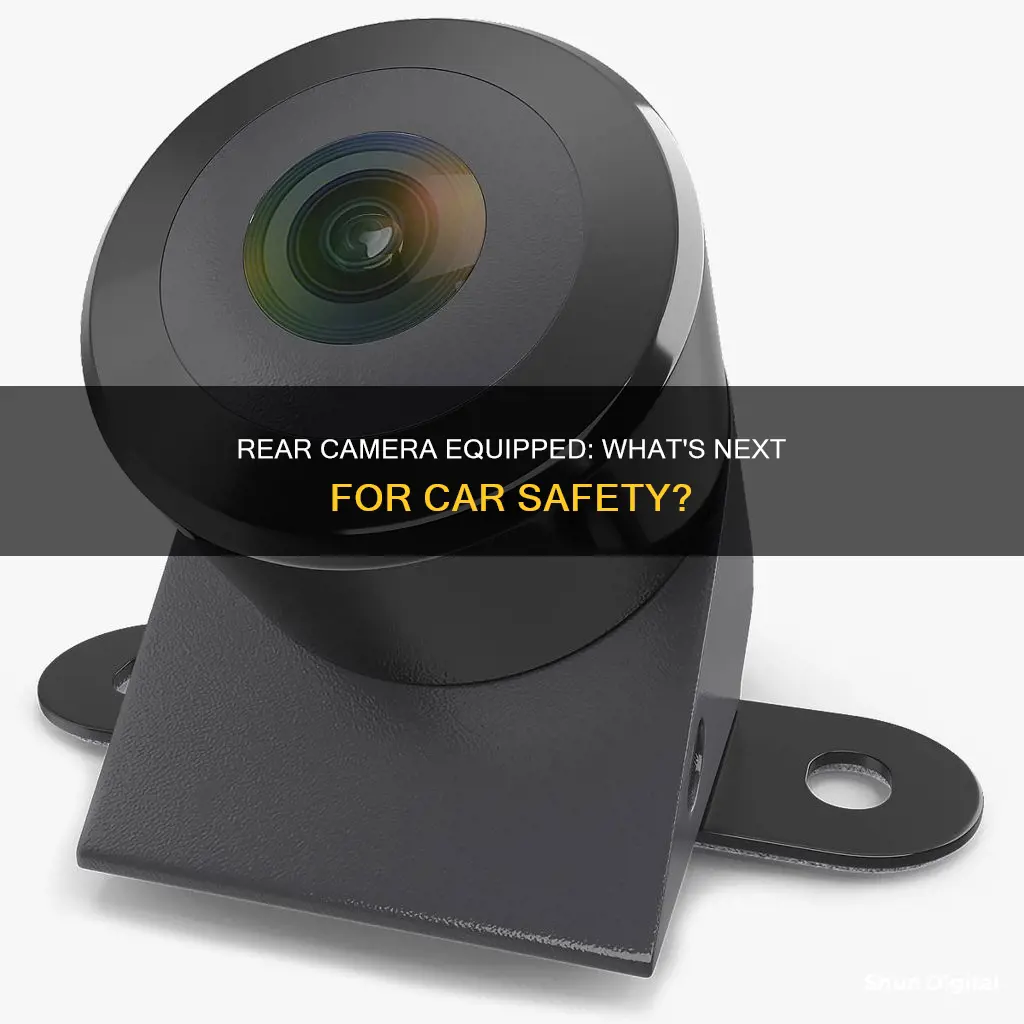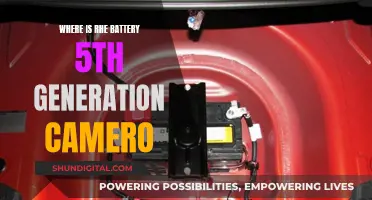
If your car already has a rearview camera, you're one of the many drivers who are now required by law to have this safety feature. Since May 2018, all new cars sold in the US have been required to have backup cameras, addressing blind spots and improving rear visibility to prevent accidents. While this is great news for new car buyers, what are the options for those with older vehicles? Aftermarket backup cameras are readily available and can be installed by professionals or even DIY-installed with relative ease. These cameras are an inexpensive way to enhance safety and convenience, providing a clear view of obstacles and expanding your field of vision. So, whether your car already has a rear camera or not, it's clear that this technology is an important tool for all drivers to consider.
| Characteristics | Values |
|---|---|
| Purpose | To enhance safety and prevent accidents, injuries, and fatalities when reversing |
| Field of View | Wider than rearview mirrors, providing a clear view of obstacles and blind spots |
| Installation | Wired or wireless, some requiring professional installation |
| Cost | $10-$500, depending on features and quality |
| Maintenance | Regular lens cleaning to ensure clear image quality |
| Benefits | Increased safety, improved visibility, easier parking, potential insurance discounts |
| Drawbacks | Potential issues with image quality, wireless connection, or system malfunction |
What You'll Learn

Backup cameras can help you park more quickly and safely
Backup cameras are now standard in all new vehicles, and for good reason. They offer a host of benefits to drivers, from increased safety to improved parking capabilities.
Enhanced Safety
Rear-facing cameras provide drivers with a much clearer and more accurate view of obstacles behind the car. This expanded field of vision, particularly below the rear window or trunk level, helps to avert injury-causing and potentially fatal backover accidents. In fact, according to government statistics, such accidents involving light vehicles result in about 210 deaths and 15,000 injuries every year, with 31% of those fatalities involving children under the age of 5. Backup cameras also help eliminate blind spots and increase visibility beyond the width of a mirror's image.
Improved Parking
In addition to enhancing safety, backup cameras can also assist with parking. The cameras give drivers a clearer view of obstacles, and most backup systems include warning tones that alert drivers when they are too close to an object. On-screen guidelines, such as dynamic gridlines, further aid in parking by showing the direction of travel and helping to direct drivers into or out of parking spaces. Some systems even feature a middle line to assist in centering the vehicle in the space. The colour of the guidelines can also change from green to yellow to red as the vehicle gets closer to an obstruction, providing a visual warning to the driver.
Other Benefits
Backup cameras are also useful when towing a trailer, as they provide a close-up view of the trailer when lining it up with the vehicle's hitch. They can also be beneficial when hooking up gooseneck or fifth-wheel trailers, helping to avoid jackknifing. Additionally, some backup camera systems offer recording functionality, allowing drivers to capture footage of their journeys.
While backup cameras offer numerous advantages, it is important to remember that they should be used in conjunction with mirrors and physically turning to look behind the vehicle. By utilising all these tools together, drivers can ensure they have a comprehensive understanding of their surroundings and can manoeuvre their vehicles safely.
Finding the Camaro's Battery: Fifth Generation
You may want to see also

They can help prevent backover accidents
Rearview cameras are now standard equipment on all new cars, and for good reason. They can help prevent backover accidents, which cause an estimated 210 deaths and 15,000 injuries every year in the United States alone. Tragically, 31% of these fatalities involve children under the age of 5.
Rearview cameras provide a clear, real-time view of what's behind your vehicle, eliminating blind spots and expanding your field of vision. This is especially important when backing up, as it allows you to see obstacles that may be below the rear window or trunk level, such as a child or a small object. Many backup cameras also have guidelines and sensors that warn you when you're getting too close to an object, further reducing the risk of an accident.
In addition to enhancing safety, rearview cameras can also provide convenience and peace of mind. They can help you park more quickly and safely, and can even assist with tasks like towing a trailer. And, in the event of an accident, a rearview camera can provide valuable evidence to support your insurance claim or legal case.
While rearview cameras are an excellent safety feature, it's important to remember that they should not be relied upon solely. It's always important to also use your mirrors and turn around to look when backing up, as cameras can malfunction or provide an obstructed view in certain conditions.
The 1970 Cameros: A Comprehensive Production Overview
You may want to see also

They can help protect your property
Rearview cameras can help protect your property by preventing accidents that could damage your car or other objects. They can also save you money in the long run by reducing the likelihood of costly repairs.
For example, backup cameras can help you park more quickly and safely by providing a clearer and more accurate view of obstacles behind your car. This can help you avoid scratches and dents that could be costly to repair. Additionally, most backup systems include warning tones that alert you when you're getting too close to an object, further reducing the risk of accidents.
Another way that rearview cameras can help protect your property is by reducing the risk of theft or vandalism. By having a clear view of your surroundings, you can be more aware of potential threats and take action to protect your vehicle. This is especially useful if you have valuable items in your car that could be tempting targets for thieves.
Furthermore, rearview cameras can also help protect your property by providing evidence in the event of an accident or insurance claim. The footage captured by these cameras can be used to determine fault and liability, which can help speed up the claims process and ensure you receive fair compensation for any damage to your vehicle.
In addition to protecting your car, rearview cameras can also help safeguard other valuable items, such as bicycles or motorcycles. By having a clear view of your surroundings, you can avoid backing into or running over these items, preventing costly repairs or replacements.
Overall, rearview cameras are a valuable investment that can help protect your property and save you money in the long run. They provide a clearer view of your surroundings, reduce the risk of accidents, and enhance the security of your vehicle and other possessions.
Charging Your Canon Powershot SX40: A Quick Guide
You may want to see also

They can save you money on insurance
If your car already has a rear camera, you may be able to save money on your insurance. Since 2018, all new cars in the US have been required by law to have a reversing camera. This is because backup cameras help to save lives, particularly those of children and seniors.
Some insurance companies offer a safety feature discount if your car has a backup camera. This is because backup cameras can help to prevent accidents and make your car safer. While there are currently no auto insurance discounts specifically for having a backup camera, you may be able to get a small safety features discount or an anti-lock brakes discount if your car has a backup camera.
In addition to the potential insurance savings, a rear-facing camera can help you to avoid injury-causing and potentially fatal accidents by expanding your field of vision and helping you to see obstacles behind your car. Backup cameras can also be especially helpful if you tow a trailer, as they give you a close-up view of the trailer as you line it up with your vehicle's hitch.
If your car doesn't already have a backup camera, you can install one yourself by purchasing an aftermarket option. These typically range in price from less than $50 to a few hundred dollars. You can also have a professional install the camera for you, which may be a better option if you're uncomfortable dealing with your car's electrical system.
Surveillance Cameras: Security for ATM Machines and Their Users
You may want to see also

They can help prevent injuries and fatalities
Rear-view cameras can help prevent injuries and fatalities by providing drivers with a clear view of their blind spots. This is especially important when backing up, as it can be difficult to see small children or objects that may be in the way. According to the National Highway Traffic Safety Administration, there are an estimated 210 fatalities and 15,000 injuries each year due to back-over crashes, with 31% of those fatalities being children under the age of 5.
Rear-view cameras can also assist with parking, providing a clearer view of obstacles and helping to eliminate blind spots. In addition, many backup camera systems include warning tones that alert drivers when they are getting too close to an object. This can be extremely helpful in preventing accidents and reducing injuries.
The use of rear-view cameras has been shown to be effective in reducing fatalities from back-over accidents. While the number of vehicles with backup cameras more than doubled over a three-year period, the fatality rate from these types of accidents fell by more than 30%. This demonstrates the potential life-saving impact of rear-view cameras.
Furthermore, rear-facing cameras can also help to protect property. By providing a view of the area directly behind the vehicle, drivers can avoid backing into objects or running over bicycles, toys, or other valuable items. This not only prevents damage to property but also saves money and aggravation.
In summary, rear-view cameras are an essential safety feature for all vehicles. They help prevent injuries and fatalities by expanding the driver's field of vision, eliminating blind spots, and providing warnings of potential obstacles. With their ability to reduce the risk of accidents and protect both people and property, rear-view cameras are a valuable tool for any driver.
Displaying Your iPad Camera Feed on a Computer
You may want to see also
Frequently asked questions
You're already one step ahead! Since May 2018, it has been a legal requirement for all new vehicles sold in the US to be equipped with rearview cameras. This law was implemented to improve safety and reduce accidents, particularly when reversing.
Rear cameras offer a wide range of benefits, including increased safety by reducing blind spots, preventing injuries and fatalities, and making parking easier. They can also help you save money on insurance, as some companies offer discounts for cars with safety features like rear cameras.
While rear cameras are a valuable safety tool, it's not advisable to rely on them solely. They may malfunction or stop working due to electrical issues or damage, so it's important to also use your mirrors and turn around to check your surroundings when reversing.







